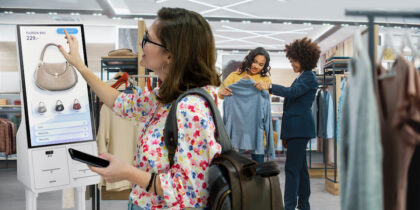Trends drive a lot of consumer purchases. So retailers have spent years learning to read the market and offer compelling new merchandise at the peak of excitement. But when it comes to retail technology trends, many retailers have safely waited to see what has staying power before they make a move.
Those days are history. To compete in today’s marketplace, retailers must become as agile, aggressive and insightful in selecting technology as they are in choosing products, so they can keep meeting consumers’ constantly evolving expectations for a great shopping experience.
Retailers are getting the message. Retail “winners” are far more likely to say their board of directors is demanding innovation — 79 percent, versus 44 percent for “average and lagging performers,” according to Retail Systems Research. As a result, these winners:
- Are more focused while ideating
- Are more interested in doing different things than their competitors
- See innovation as a viable way to add value to their overall brand
- Are more willing to fail fast
- Look everywhere they can for inspiration
- Consider every real-world solution that could possibly help in their efforts
Disrupt or Be Disrupted
A key source of innovation in retail these days is technology. Retailers are throwing out old formulas on how much to spend on IT, boosting overall enterprise IT spending by 5.2 percent in 2019 and store IT spending by 5.4 percent, according to RIS News.
Transform Retail Associate Performance
Get your free guide to empowering retail associates with mobile devices and data. Download Now
Smart retailers are particularly attuned to spotting technologies with the potential to disrupt current ways of doing business, so they can stay on trend rather than lose market share to more innovative competitors.
Here are five such retail technology-related trends we think are worth watching in 2020.
1. Store Associate 2.0
Elevating the role of the store associate pays off. Interacting with a sales associate makes customers 43 percent more likely to buy and 12 percent more likely to revisit, and their purchases garner 81 percent more value for the retailer, according to Mindtree.
Access to technology is making that happen. Chico’s is now linking store associates with online sales transactions and compensating them regardless of which channel the customer uses for purchase, Forbes reported. Sak’s Fifth Avenue equips its “Style Advisors” with tablets to look up inventory, perform transactions and access customer information, according to ClickZ. They also have their own home pages on Saks.com and can connect directly with customers on Instagram. When associates become a resource, consumers respond.
2. Breaking Through the Screen
As stores strive to become more like digital, digital is working to become more like the store. Live commerce, for example, combines streaming video with e-commerce. One Chinese e-commerce site enables consumer-to-consumer live streaming where viewers can ask questions of influencers and learn skills such as makeup application techniques, according to Forbes, while Amazon Live brings a Home Shopping Network-like experience online. Meanwhile, Neiman Marcus enables shoppers to upload photos to help find merchandise via intelligent visual search in its Snap. Find. Shop. app, as reported by Slyce.
According to one contributor to Medium, both could be precursors to the real disrupter, the Spatial Web — a computing environment that exists in three-dimensional space, so users can build an exact copy of their physical reality in the virtual domain and bring the digital into their real environments.
3. Artificial Intelligence for Supply Chain
While 74 percent of artificial intelligence (AI) use cases in retail are focused on the customer experience, Capgemini estimates that retailers could save as much as $340 billion by taking AI to scale across the value chain. AI has the potential to increase efficiency and identify and prevent mistakes while delivering predictive logistics, visual-aided picking and warehouse robotics controls.
The Capgemini report tells us Tesco, JD.com and Alibaba are using AI for route optimization, while Forbes wrote that Stitch Fix leverages AI to fulfill orders based on the client and inventory locations, as well as to optimize the pick route and consider possible combinations to allow shipments to be picked at the same time.
4. Sustainability and Social Responsibility
In 2020, Gen Z will represent a plurality of the consumer market, according to GreenMatch. This generation is more loyal to values than brands, and nearly half will abandon a brand that violates these values. These values include social responsibility, locally sourced food, authentic experiences and sustainability, giving rise to brands such as Poshmark, Le Tote and StockX, where goods are traded or rented instead of discarded.
But it’s not just Gen Z. Marketing Dive found that most consumers want brands to stand for something and drive change. Marketing Dive also reported that “brands with a high sense of purpose have experienced a brand valuation increase of 175% over the past 12 years, compared to the median growth rate of 86%.” This is forcing these companies to alter business processes and tighten policies. Then, they must implement technologies to make sourcing data easily accessible and transparent across both digital and physical touchpoints, so sourcing becomes a prominent part of the marketing.
5. Retail 4.0
The term Retail 4.0 has emerged to encapsulate a variety of trends focused on innovating around the customer experience, from seamless omnichannel experiences to personalization to responsive merchandising. Retailers are working to reinvent the brand experience at all touchpoints, with a particular emphasis on reimagining the role of the store.
Retailers are just dipping their toes into the possible applications of advanced analytic technologies such as augmented reality (AR) and machine learning to power these processes. But it must all start with a cohesive vision and point of view that then shapes the IT road map that will enable an individual retailer to define their distinctive voice in the market.
Roaring Into the ’20s
A new year is a perfect time to step back and assess where retail has been and where it’s going. But now more than ever, it’s not enough to simply keep a finger on the pulse of the market. Retailers must set up organizations and cultures to sense new trends and test and learn from new ideas. Retail winners are proving that a successful retailer in the 2020s is an agile one.
Explore these six steps to transform your store with mobile devices for 2020. Think your in-store mobility is mature already? Find out now with this free assessment.









